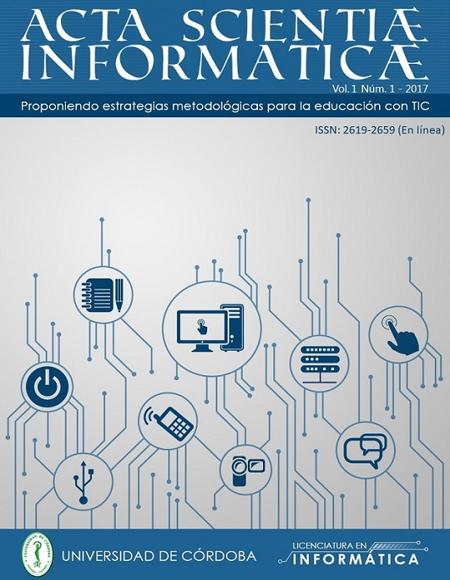Mostrar biografía de los autores
Los Tutores Cognitivos son un tipo de Sistemas Tutores Inteligentes que se basan en teorías de psicología cognitiva. Los Tutores Cognitivos utilizan arquitecturas cognitivas para analizar cada acción realizada por los estudiantes y calcular las competencias de aprendizaje que necesitan ser medidas. La programación de computadores, es una metodología de resolución de problemas que a menudo causa un conflicto en el estudiante para encontrar la solución adecuada a dicho problema.
En este artículo se presentara estudio general sobre la utilización de Arquitecturas Cognitivas dentro de Tutores cognitivos y su aplicación en el campo de la educación, se hizo una revisión bibliográfica acerca de las Arquitecturas Cognitivas basándose en la memoria y el aprendizaje, y Tutores Cognitivos creados para la enseñanza de la programación y su aplicación en la educación.
Visitas del artículo 990 | Visitas PDF
Descargas
- Abdón, I., & Aldana, M. (2002). PREGUNTAS COGNITIVAS Y METACOGNITIVAS EN EL PROCESO DE APRENDIZAJE Influencia de preguntas cognitivas y metacognitivas en comprensi{ó}n conceptual y en habilidad para resolver problemas en ciencias.
- Al-Nakhal, M. A. M., & Abu Naser, S. S. (2017). Adaptive Intelligent Tutoring System for Learning Computer TheoryAdaptive Intelligent Tutoring System for Learning Computer Theory. B+) EUROPEAN ACADEMIC RESEARCH, 9(10).
- Anderson, J., Boyle, F., Corbett, A., & Lewis, M. (1990). Cognitive Modeling and Intelligent Tutoring. Retrieved from https://www.researchgate.net/profile/Matthew_Lewis23/publication/220545766_Cognitive_Modeling_and_Intelligent_Tutoring/links/56b11a4e08ae56d7b069e9a3.pdf
- Anderson, J. R. (1995). A Simple Theory of Complex Cognition.
- Anderson, J. R. (2013). The architecture of cognition. Psychology Press.
- Anderson, J. R., Bothell, D., Byrne, M. D., Douglass, S., Lebiere, C., & Qin, Y. (2004). An integrated theory of the mind. Psychological Review, 111(4), 1036.
- Anderson, J. R., Bothell, D., Lebiere, C., & Matessa, M. (1998). An Integrated Theory of List Memory-ent aspects of cognition—memory for serial. JOURNAL OF MEMORY AND LANGUAGE, 38, 341–380. Retrieved from http://citeseerx.ist.psu.edu/viewdoc/download?doi=10.1.1.330.9219&rep=rep1&type=pdf
- Anderson, J. R., & Bower, G. H. (2014). Human Associative Memory. Taylor and Francis. Retrieved from https://books.google.es/books?hl=es&lr=&id=R0XrAgAAQBAJ&oi=fnd&pg=PP1&dq=human+associative+memory&ots=xXHaz8t65P&sig=hyI-we0CH_QY3a2hgXkaFzwH5og#v=onepage&q=human associative memory&f=false
- Anderson, J. R., Boyle, C. F., Farrell, R., & Reiser, B. J. (1984). Cognitive Principles in the Design of Computer Tutors. Retrieved from http://oai.dtic.mil/oai/oai?verb=getRecord&metadataPrefix=html&identifier=ADA144825
- Anderson, J. R., Conrad, F. G., & Corbett, A. T. (1989). Skill Acquisition and the LISP Tutor. Cognitive Science, 13(4), 467–505. https://doi.org/10.1207/s15516709cog1304_1
- Anderson, J. R., Corbett, A. T., Koedinger, K. R., & Pelletier, R. (1995). Cognitive tutors: Lessons learned. The Journal of the Learning Sciences, 4(2), 167–207.
- Anderson, J. R., & Lebiere, C. (1998). The atomic components of thought. Erlbaum.
- Arellano, N., Fernandez, J., Rosas, M. V., & Zuñiga, M. E. (2014). Estrategia metodológica de la enseñanza de la programación para la permanencia de los alumnos de primer año de Ingeniería Electrónica, 55–60. Retrieved from http://sedici.unlp.edu.ar/bitstream/handle/10915/39993/Documento_completo.pdf?sequence=1
- Arévalo, C., & Solano, L. (2013). Patrones de Comportamiento de Estudiantes de Programación al Utilizar una Herramienta de Visualización de Protocolos Verbales. Retrieved from https://www.researchgate.net/profile/Carlos_Mercado2/publication/303365283_Patrones_de_Comportamiento_de_Estudiantes_de_Programacion_al_Utilizar_una_Herramienta_de_Visualizacion_de_Protocolos_Verbales/links/573e26e208ae298602e6e041/Patrones-de-Comportamie
- Barros, G. T. (2000). Un modelo de Arquitectura Cognitiva Aplicación en Robótica Móvil Tesis Doctoral. Retrieved from http://oa.upm.es/641/1/10200011.pdf
- Barroso, J. J., & Ortiz, I. R. R. (2007). Dificultades de aprendizaje e intervención psicopedagógica en la resolución de problemas matemáticos, 342, 257–286. Retrieved from http://www.revistaeducacion.mec.es/re342/re342_13.pdf
- Cala, O. (2014). Estudio comparativo del funcionamiento de Sistemas tutores inteligentes orientados a la enseñanza de los fundamentos de Control Automático. Universidad Nacional de Colombia.
- Cataldi, Z., & Lage, F. J. (2010). Modelado del estudiante en sistemas tutores inteligentes. TE {&} ET.
- Constanza Raquel Huapaya, & Lic. Laura Lanzarini. (2009). Sistemas Tutoriales Inteligentes Un analisis crıtico. Retrieved from http://sedici.unlp.edu.ar/bitstream/handle/10915/4169/Documento_completo.pdf?sequence=1
- Coppo, R., Iparraguirre, J., Feres, G., Ursua, G., & Cavallo, A. (2011). Sistema didáctico para la enseñanza de la programación con metodologías de aprendizaje basado en problemas. Retrieved from http://sedici.unlp.edu.ar/bitstream/handle/10915/19923/Documento_completo.pdf?sequence=1
- Corbett, A. (2000). Cognitive Mastery Learning in the ACT Programming Tutor. Retrieved from http://www.aaai.org/Papers/Symposia/Spring/2000/SS-00-01/SS00-01-007.pdf
- Corbett, A., & Mclaughlin, M. (2000). Modeling Student Knowledge: Cognitive Tutors in High School and College.
- Corbett, A. T., & Anderson, J. R. (1995). Knowledge Tracing: Modeling Acquisition of Procedural Knowledge.
- Corbett, A. T., & Anderson, J. R. (2008). Knowledge decomposition and subgoal reification in the ACT programming tutor. Department of Psychology, 81.
- Corbett, A. T., & Bhatnagar, A. (1997). Student modeling in the ACT programming tutor: Adjusting a procedural learning model with declarative knowledge. In User modeling (pp. 243–254).
- Duch, W., Oentaryo, R. J., & Pasquier, M. (2008). Cognitive
- Architectures: Where do we go from here? In AGI (Vol. 171, pp. 122–136).
- Fancsali, S., Nixon, T., Vuong, A., & Ritter, S. (2013). Simulated Students, Mastery Learning, and Improved Learning Curves for Real-World Cognitive Tutors. Retrieved from https://www.researchgate.net/profile/John_Champaign/publication/260722477_Simulated_Learners/links/02e7e5390d2a7d2fbf000000.pdf#page=15
- Garay, I. M., & Castro, J. (2010). TUTORES INTELIGENTES EN LA ENSEÑANZA DE LA MATEMÁTICA EN SECUNDARIA. Retrieved from http://funes.uniandes.edu.co/4799/1/MoralesTutoresALME2010.pdf
- Goldstein, I. P. (1979). The genetic graph: a representation for the evolution of procedural knowledge. International Journal of Man-Machine Studies, 11(1), 51–77. https://doi.org/10.1016/S0020-7373(79)80005-X
- Jiménez, M., Universidad De Costa, C., Rica, R. C., Salas, E., Ogan, A., & Baker, R. S. J. D. (2011). Tutor Cognitivo y el incremento de aprendizaje en matemática.
- Langley, P., Laird, J. E., & Rogers, S. (2006). Cognitive architectures: Research issues and challenges. COGNITIVE SYSTEMS RESEARCH. https://doi.org/10.1016/j.cogsys.2006.07.004
- Mercado, A., Argelio, C., Reynoso, G., & Manuel, J. (2010). Un estudio piloto sobre el efecto de los tutores cognitivos para la enseñanza de conceptos básicos de programación. In Investigación y Ciencia (Vol. 18, pp. 17–29). Retrieved from http://redalyc.uaemex.mx/src/inicio/ArtPdfRed.jsp?iCve=67413203004
- Olier, A. ., Gómez, A. A., & Caro, M. F. (2017). Design and Implementation of a Teaching Tool for Introduction to Object Oriented Programming, 15. Retrieved from http://www.ewh.ieee.org/reg/9/etrans/ieee/issues/vol15/vol15issue01Jan.2017/15TLA1_13OlierQuiceno.pdf
- Oscar Javier Romero Lopez. (2011). Arquitectura Hıbrida para Sistemas Cognitivos Artificiales con Comportamiento Emergente, Adaptativo y Auto-organizado. Retrieved from http://dw.crackmypdf.com/0059959001489075171/romero_oscar_tesis.pdf
- Reusser, K. (1993). Tutoring systems and pedagogical theory: Representational tools for understanding, planning, and reflection in problem solving. Computers as Cognitive Tools, 1, 143–177.
- Roberts, M. R., Alves, C. B., Chu, M.-W., Thompson, M., Bahry, L. M., & Gotzmann, A. (2012). Testing Expert-Based vs. Student-Based Cognitive Models for a Grade 3 Diagnostic Mathematics Assessment.
- Ruiz, J. G., Hernández López, M., & Loaiza Brito, J. A. (2015). REVISTA ELECTRÓNICA ANFEI DIGITAL PENSAMIENTO SISTÉMICO Y DESARROLLO DE COMPETENCIAS, EN EL APRENDIZAJE DE LOS LENGUAJES DE PROGRAMACIÓN. Año 1, (2). Retrieved from http://www.anfei.org.mx/revista/index.php/revista/article/viewFile/108/443
- Ruiz Sánchez de León, J. M., & Fernández Blázquez, M. A. (2011). Arquitecturas cognitivas y cerebro: hacia una teoría unificada de la cognición. International Journal of Psychological Research, ISSN-E 2011-2079, Vol. 4, No. 2, 2011, Págs. 38-47, 4(2), 38–47. Retrieved from https://dialnet.unirioja.es/servlet/articulo?codigo=3904273
- Salgueiro, F. A., Costa, G., Cataldi, Z., García Martinez, R., & Lage, F. J. (2005). Sistemas inteligentes para el modelado del tutor. Proc. GCETE, Brazil, 63.
- Scherer, R. (2016). Learning from the Past-The Need for Empirical Evidence on the Transfer Effects of Computer Programming Skills. Frontiers in Psychology, 7, 1390. https://doi.org/10.3389/fpsyg.2016.01390
- Schoenfeld, A. H. (1985). Mathematical problem solving. Academic Press.
- Sun, R. (2007). The importance of cognitive architectures: An analysis based on CLARION. Journal of Experimental {&} Theoretical Artificial Intelligence, 19(2), 159–193.
- Sun, R., & Alexandre, F. (1997). Connectionist-symbolic integration : from unified to hybrid approaches. Lawrence Erlbaum Associates. Retrieved from https://books.google.es/books?hl=es&lr=&id=FBlga7dU-IsC&oi=fnd&pg=PP1&dq=Connectionist+symbolic+integration&ots=QBgNH_siNh&sig=7AzOqvXj8RH1AlhZ-Dz_I29H9rE#v=onepage&q=Connectionist symbolic integration&f=false
- Sun, R., & Zhang, X. (2004). Top-down versus bottom-up learning in cognitive skill acquisition. Cognitive Systems Research, 5(1), 63–89.


